The development of the IPv6 Internet has diversified the ways in which it is accessed. IPv6 users initially stayed within reach of hardwired IP networks by working from a Campus or an Enterprise network.
As IPv6 functionality and benefits have become generally accepted understood, the demand to access IPv6 Internet from any location has grown. This includes various access technologies with PPP and DSL. Cisco IOS® Software has been extended to meet this demand, and thus scale large IPv6 deployment. Typically that means automatic and per user IPv6 address assignment, which covers the Authentication, Authorization, and Accounting (AAA) extensions for IPv6. This includes address pool management and RADIUS extensions, as well as deployment of those features. IPv6 access operational design choices are addressed as well.
The content of this paper focus on the Cisco IOS IPv6 Broadband Access feature set, as introduced Cisco IOS Software Release 12.2(13)T and Release 12.2(13)B or above.
To determine the exactly feature set supported on a given release or hardware, please refer to:
The deployment of IPv6, and its specific nature have highlighted the operational requirements that differ between IPv6 and IPv4 access technologies operations. For example, IPv6 enables long-lived address allocation, as there are much more IPv6 addresses; this is the solution in most cases.
Static allocation is also a requirement resulting from the proliferation of servers, typically home appliances. This option was not possible with IPv4, because of the IP address shortage and the ability of IPCP to deliver a non-permanent, single address to end-customers.
An IPv6 user receives an address prefix, rather than a single address, in contrast to an IPv4 user. Typically, the ISP will assign a /64 or a /48 address prefix. Note also that an IPv6 host can use multiple addresses within one address prefix (e.g. temporary addresses). It generally leverages IPv6 to assign long-lived address prefixes to end-users. In a typical architecture, the user is tunnelled to their home gateway, so this does not pose specific problems. However this will have impact the routing system during a scenario in which each Network Access Server (NAS) has a pool of addresses, and users receive address from this pool when they dial. If users dial another Point Of Presence (POP), or are connected to another NAS at the same POP, they will receive a different IPv6 address prefix. If there is a permanent IPv6 address prefix, a route for each user's address prefix must be advertised into the routing system. This is a problem, because it introduces potential routing table de-aggregation in the cases of broadband access and roaming customer.
While it is possible to deploy IPv6 on all access media, including low speed media, some access methods are clearly better positioned to leverage IPv6 specificity. DSL and other always-on access technologies will benefit from long-lived address assignments to host servers, which enable many inbound connections. PPPoE, PPPoA, and RBE1 access methods are good candidate encapsulations to offer IPv6 connectivity in a variety of access service ISP designs.
Current RADIUS attributes show IPv4 dependencies, which are encoded to support 32 bit addresses and run over an IPv4 transport. IPv6 RADIUS attributes carry IPv6 addresses and make room for concepts such as IPv6 address prefix assignments, as the IPv4 dialup model assign only IPv4 host addresses. It will soon also be desirable to allow the RADIUS protocol to run over an IPv6 transport.
It is crucial that large-scale IPv6 access deployments be able to automatically assign IPv6 address prefixes to end users, connecting via PPP. In IPv6, address assignment occurs at the network layer; conversely, in IPv4, a number of functions occur in the PPP layer. As IPCP configures IPv4 over PPP, IPV6CP configures IPv6 over PPP. IPv6CP negotiates a unique interface identifier, while all of functions are performed in Layer 3. Host address auto-configuration is performed at reception of Router Advertisement messages (RA).
IPv6 allocates many more IP addresses to the end user than does IPv4. This will clearly lead to a proliferation of routers (Customer Premise Equipment (CPE)) connected to always-on services (i.e.: Digital Subscriber Line (DSL), cable).
No IPv6 mechanism offers native auto-configuration for the configuration of router interfaces, but this does exist for host address configuration. However, in the IPv6 access model architecture, it is key to dynamically provide a router with a variable length address prefix for the assignment of interfaces addresses. This prevents mistakes in manual configuration, eases the propagation of addresses changes. The CPE will typically receive a /48 address prefix and, out of it, will number its interfaces with /64 address prefixes.
The IETF is currently considering several propositions to fulfill this requirement:
Both of the aforementioned techniques are media-independent, as they operate at Layer 3.
Follow are two possible access architectures.
Figure 1 depicts a wholesale architecture with L2TP Access Concentrator (LAC) and L2TP Network Server (LNS) functions. The ISP-customer link supports IPv6 in order to provide an IPv6 service to the end-user.2
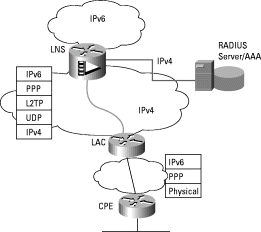
Figure 2 depicts ISP operated broadband access architecture with the Network Access Server (NAS) function. The ISP-customer link supports IPv6 in the same manner as in Figure 1. However the RADIUS dialog between the NAS and the AAA server occurs over an IPv4 transport.
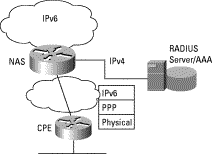
Encapsulations such as PPPoA, PPPoE, RBE, ISDN and Asynchronous access can leverage the IPv6 extensions to the AAA function. It is clear that always-on technologies, including DSL, will be predominant in the coming years, to the detriment of classical IPv4 access technologies (i.e.: ISDN or Asynchronous access). This section thus focuses on models working with DSL: PPPoA, PPPoE and RBE.
PPP over ATM adaptation Layer 5 (AAL5) [RFC 2364] is created between the CPE and Access Concentrator. The IPv6 traffic originated by the user's PC flows over Ethernet to the CPE is encapsulated over PPP to flow between the CPE and the Access Concentrator. Unlike the PPPoE approach, this necessitates a Layer 3 aware (and thus consequently IPv6 aware) CPE. After a PPP session is established, the CPE and the Access Concentrator must allocate the resources for a PPP virtual interface and configure IPv6 over it. Figure 3 depicts the global architecture for PPPoA.

The PPPoE feature defined in RFC2516 is put to contribution to transmit IPv6 traffic between the user's PC and the Access Concentrator through the CPE over PPP. The CPE is Layer 3 unaware, consequently IPv6 unaware. After a PPP session is established, both the host and the Access Concentrator must allocate resources for a PPP virtual interface and configure IPv6 over that interface.
Figure 4 depicts the global architecture for PPPoE. Alternatively, the CPE can be the PPPoE session end-point, which eliminates the need to install specific software on the customer's PC.

The ATM Routed Bridge Encapsulation1 (RBE) feature routes IPv6 over bridged [RFC 2684] Ethernet traffic from a stub-bridged LAN. An ATM interface that is configured in route-bridged mode receives bridged IPv6 packets, which are routed via the IPv6 header. Such interfaces leverage the characteristics of a stub LAN topology, which is commonly used for DSL access and offers increased performance and flexibility over integrated routing and bridging (IRB). Figure 5 depicts the global architecture for RBE.
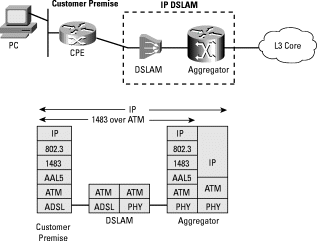
Stateless address auto-configuration works when the CPE is a single PC or a router limited to only one subnet.
When a single host connects via a PPP link, the address prefix is advertised to the user in a Router Advertisement (RA) message. The address prefix advertised in the RA can come from an AAA server (the prefix attribute), manual configuration, or allocation from a prefix pool. The host gets a /64 address prefix and automatically configures its address based on the address prefix. The Interface-ID portion of the address can come from Framed-Interface-Id AAA attribute, a derivation of the MAC address, or arbitrary assignment.
When the CPE is a router, auto-configuration of hosts attached to a segment of this router is achieved in bridging the RA messages from the PPP link to the local Ethernet segment.
The current Cisco IOS Software implementation of IPv6 on RADIUS uses Cisco Vendor Specific Attributes (VSA). The corresponding standard RADIUS attributes defined in [RFC 3162] exist. [RFC 3162] support on the ISP RADIUS server requires an upgrade of this software, and no widely deployed RADIUS solution currently supports this functionality. However, Cisco recognizes the importance of standards and will deliver an RFC3162 solution in future releases of Cisco IOS Software.
Table 1 depicts the correspondence, when it exists, between RFC3162 and Cisco VSA. As the current Cisco IOS Software implementation does not support RADIUS over an IPv6 Transport, some translation did not make sense. However, "Framed Interface ID" is already supported.
| RFC 3162 | Cisco VSA |
|---|---|
|
NAS-IPv6-Address |
|
|
Framed-Interface-Id |
|
|
Framed-IPv6-Prefix |
IPv6 prefix |
|
Login-IPv6-Host |
|
|
Framed-IPv6-Route |
IPv6 route |
|
Framed-IPv6-Pool |
IPv6 pool |
|
IPv6 ACL {in, out} |
Apart from the new "IPv6 prefix" attribute, the new Cisco VSAs are IPv4 attribute extended to support the IPv6 protocol. In addition to the aforementioned translated Cisco VSA, "IPv6 ACL {in, out}" is a Cisco VSA attribute with no correspondence in RFC3162.
The "route#" attribute allows the operator to specify a per-user static route. The format is the same as a Cisco IOS Software "ipv6 route" command. The following example specifies a route to "3ffe:ffff:1::/48" and a route to 3ffe:ffff:2::/48".
cisco-avpair = "ipv6:route#1=3ffe:ffff:1::/48",
cisco-avpair = "ipv6:route#2=3ffe:ffff:2::/48",
The "inacl#<n>" and "outacl#<n>" attributes allow the user to specify a complete IPv6 access-list. The unique name of the access-list is generated automatically. When the user logs out, the access-list is removed, and the previous access-list on the interface (if any) is re-applied.
cisco-avpair = "ipv6:inacl#1=permit 3ffe:ffff:1::/48",
cisco-avpair = "ipv6:outacl#1=deny fec0::/10",
The "inacl" and "outacl" attributes let the user refer by name to an existing access-list configured on the router.
cisco-avpair = "ipv6:inacl=filter-n1",
The corresponding Router configuration would be the following:
ipv6 access-list remove-n1 permit ipv6 3ffe:ffff:1::/48 any deny ipv6 fec0::/10 any
The "prefix#" attribute allows the user to specify which address prefixes to advertise in Neighbor Discovery Router Advertisement messages. The format used is as specified for the "ipv6 nd prefix" command. A corresponding route (marked as a per-user static route) will be installed in the RIB for the address prefix.
The following RADIUS configuration associates the address prefix "3ffe:ffff:5::/64" to a user.
cisco-avpair = "ipv6:prefix#1=3ffe:ffff:5::/64",
This attribute extends the existing IPv4 "addr-pool" RADIUS attribute to support the IPv6 protocol. It specifies the name of a local pool from which to get the address prefix, and is used with "service=ppp" and "protocol=ipv6". The specified pool must be pre-configured on the NAS. The following command creates the "foo" IPv6 pool.
cisco-avpair = "ipv6:addr-pool=foo",
IPv6 prefix pools and IPv4 address pools have similar functions. Contrary to IPv4, entire address prefixes are allocated, typically /64s, and not single addresses. A pool is locally configured and cannot be changed after it is configured, as a change in configuration would remove and recreate the pool. All address prefixes already allocated will also be freed.
3.1.5.1 Shared prefix pools
A /64 address prefix is shared between all users of the pool. All interfaces send RAs for the same /64 address prefix. The user gets a /128, based on the address prefix and specific Interface-Identifier attribute. A per-user static route is installed in the RIB for the /128. Each user can receive only one address from the pool. Shared pools are not a recommended way to assign IPv6 addresses to end-users, as it would preclude auto-configuration, and unnecessarily restricts each user to a single address. The following command creates address prefix "3ffe:ffff:7::/64" as a shared pool.
ipv6 prefix-pool foo 3ffe:ffff:7::/64 128 shared
3.1.5.2 Normal prefix pools
Separate /64 are assigned to each user. The address prefix is advertised in RA and a route is installed in the RIB. The following command creates address prefix "3ffe:ffff:8::/48" as a prefix pool for /64 allocation.
ipv6 prefix-pool foo 3ffe:ffff:8::/48 64
The RADIUS configuration corresponding to this feature requires that "users" files, which describe users' configuration, be edited. The following example creates an account for user "user@isp.net". Outgoing packets with site local address are blocked. A fixed /64 address prefix is assigned to this user.
user@isp.net Password = secret
Service-Type = Framed,
Framed-Protocol = PPP,
Cisco-AVpair = "ipv6:prefix#1=3ffe:ffff:5::/64",
Cisco-AVPair = "ipv6:outacl#1=deny fec0::/10 any"
When there are several sources for obtaining an address prefix, follow this sequence:
1. AAA provided address prefix or prefixes from the pool named by AAA
2. An address prefix from a local prefix pool
3. Manually configured through the "ipv6 nd prefix" command.
This global command configures an IPv6 prefix pool. The address prefix is included in the advertised RA on the interface, and it is possible to specify the length of this prefix that will be assigned to the customer. However, it is strongly recommended that the assigned address prefix length be 64, which allows for stateless address auto-configuration to work. If the "shared" keyword is specified, each user of the pool shares a single /64.
The prefix pool cache tracks the most recently used entries. The cache maintains information about users that disconnect, so they are re-assigned the same address prefix upon re-connection. The cache sized is adjustable, because of the cache size parameter.
The following command creates a /56 pool "foo" and from which each user is assigned a /64 address prefix. The cache size is 1000 entries.
ipv6 local pool foo 3ffe:ffff:a::/56 64 cache-size 1000
This interface command configures which pool the client should assigned from. In the following example, the "foo" pool is assigned to Virtual-template1.
interface Virtual-Template1
ipv6 enable
no ipv6 nd suppress-ra
peer default ipv6 pool foo
ppp authentication chap
This interface command enables ATM Routed Bridge Encapsulation feature to route IPv6 over bridged [RFC 2684] Ethernet traffic from a stub-bridged LAN.
atm route-bridge ipv6
The following command displays IPv6 Prefix Pool information, which includes cache information.
Router#show ipv6 local pool foo Prefix is 3FFE:FFFF:A::/56 assign /64 prefix 2 entries in use, 254 available, 0 rejected 0 entries cached, 1000 maximum User Prefix Interface joe 3FFE:FFFF:A::/64 Vi1 john 3FFE:FFFF:A:1::/64 Vi2
This command displays IPv6 interface related parameters, addresses, and address prefixes.
Router#show ipv6 int vi1
Virtual-Access1 is up, line protocol is up
IPv6 is enabled, link-local address is FE80::205:5FFF:FEAF:2C08
No global unicast address is configured
Joined group address(es):
FF02::1
FF02::2
FF02::1:FFAF:2C08
MTU is 1480 bytes
ICMP error messages limited to one every 100 milliseconds
ICMP redirects are enabled
ND DAD is enabled, number of DAD attempts: 1
ND reachable time is 30 milliseconds
ND advertised reachable time is 30 milliseconds
ND advertised retransmit interval is 0 milliseconds
ND router advertisements are sent every 200 seconds
ND router advertisements live for 1800 seconds
Hosts use stateless autoconfig for addresses.
Router#show ipv6 int vi1 prefix
IPv6 Prefix Advertisements Virtual-Access1
Codes: A - Address, P - Prefix-Advertisement, O - Pool
X - Proxy RA, U - Per-user prefix, D - Default
N - Not advertised, C - Calendar
O 3FFE:FFFF:A::/64 [LA] valid lifetime 2592000 preferred lifetime 604800
This debug command enables IPv6 Prefix Pool debugging.
2w4d: IPv6 Pool: Deleting route/prefix 3FFE:FFFF:A::/64 to Virtual-Access1 for cisco 2w4d: IPv6 Pool: Returning cached entry 3FFE:FFFF:A::/64 for cisco on Virtual-Access1 to foo 2w4d: IPv6 Pool: Installed route/prefix 3FFE:FFFF:A::/64 to Virtual-Access1 for cisco
When creating an IPv6 access service, the ISP must make decisions in several areas, sometimes showing dependencies to each other's.
Most commonly, a /48 will be delivered to every remote site with more than one subnet. A /64 will be assigned to a customer with only one subnet or a host. As a last resort, a /128 might be assigned to individual remote PCs.
The customer address allocation will be either static or dynamic:
One possible addressing option is the assignment of a permanent /64 address prefix to a single PC or a to a router with a single segment. However, this can limit a router's functionality, because it does not leave room for extension behind the router. For a PC or a router, the NAS will send an RA along the link.
There are two options available for a single PC:
When the router has a single link, the router LAN may be configured based on this permanent address prefix, because the /64 address prefix is permanent. An RA with this permanent address prefix can be sent to the router, increasing the flexibility of this deployment.
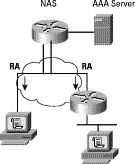
5.1.1.1 CPE config
ipv6 unicast-routing ! interface Ethernet0 ipv6 address 3ffe:ffff:4567:1234::1/64
5.1.1.2 RADIUS config
This is the appropriate user configuration when there is a permanently assigned /64 address prefix:
Auth-Type = Local, Password = "foo" User-Service-Type = Framed-User, Framed-Protocol = PPP, cisco-avpair = "ipv6:prefix=3ffe:ffff:4567:1234::/64 Interface Identifier attribute can be specified: Interface-Id = "0:0:0:1",
The preferred addressing option is to assign a permanent /48 address prefix to a router. It is not limiting in the sense that it allows any network extension behind the router. However, as there is no current standard means of transmitting this address assignment to the remote router, manual address assignment occurs on the router. It would not make sense to assign temporary /48 address prefixes, which would generate several manual routers renumbering.
With the help of a future Prefix Delegation protocol, it will be possible to transmit the address prefix to the remote router for auto-configuration.
5.1.2.1 CPE config
The CPE interfaces will be configured manually from the assigned /48 address prefix.
5.1.2.2 RADIUS config
In the user profile a /48 route pointing to the customer link is added.
Auth-Type = Local, Password = "foo"
User-Service-Type = Framed-User,
Framed-Protocol = PPP,
cisco-avpair = "ipv6:route=3ffe:ffff:b::/48
Assigning a /128 address prefix to a single PC is a possible addressing option. This solution may be deployed in environments where the connection is temporary; however, IPv6 does not bring anything on top of a classical IPv4 remote access scheme in this case. If there is a requirement for a permanent address, then the Interface-Id RADIUS attribute may be used. An RA with a /128 address prefix is sent along the link with the address prefix.
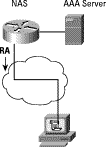
5.1.3.1 RADIUS config
The user configuration in the case of a temporarily assigned /128 is the following.
Auth-Type = Local, Password = "foo" User-Service-Type = Framed-User, Framed-Protocol = PPP, cisco-avpair = "addr-pool= 1" cisco-avpair = "ipv6:pool#1=3ffe:ffff:c::/64",
It is possible to assign a short live /64 address prefix to a single PC or a very simple network. This is limiting, as it forces renumbering at each connection attempt. A different /64 RA is sent every time if there is a single PC. Manual router renumbering is required for routers. Router configuration does not differ from permanent /64 case.
5.1.4.1 RADIUS config
Auth-Type = Local, Password = "foo" User-Service-Type = Framed-User, Framed-Protocol = PPP, cisco-avpair = "addr-pool="foo-shared"
5.1.4.2 NAS configuration
ipv6 prefix-pool foo-shared 3ffe:ffff:e::/48 64
The following configuration applies to DSL access with PPPoA encapsulation as described in Figure 1, 2, and 3.
interface FastEthernet0 ipv6 address 3FFE:ffff:123:1999::1/64 ! interface atm0 no ip address no ip directed-broadcast no ip mroute-cache pvc <vpi/vci> encapsulation aal5mux ppp dialer dialer pool-member 1 ! interface dialer1 encapsulation ppp dialer pool 1 dialer-group 1 ipv6 address autoconfig ipv6 nd ra-interval 180 ipv6 nd ra-lifetime 3600 ppp authentication chap foo ppp chap hostname user@domain.net ppp chap password 7 1111111111 ppp ipcp address accept ! ipv6 route ::/0 Dialer1
aaa new-model aaa authentication login default none aaa authentication ppp default group radius aaa authorization network default group radius aaa accounting network default wait-start group radius ! interface Loopback0 ipv6 address 3FFE:ffff:123:1::1/64 ! interface ATM0/0/0.1 point-to-point no ip directed-broadcast pvc 1/32 encapsulation aal5mux ppp Virtual-Template1 ! interface Virtual-Template1 ipv6 enable ipv6 mtu 1480 ipv6 nd reachable-time 30 no ipv6 nd suppress-ra ppp authentication pap peer default ipv6 pool foo ! ipv6 local pool foo 3ffe:ffff:a::/56 64 cache-size 1000 ! radius-server host 192.168.2.20 auth-port 1645 acct-port 1646 radius-server key radius-password
aaa new-model aaa authentication login default none aaa authentication ppp default group radius aaa authorization network default group radius aaa accounting network default wait-start group radius ! vpdn-group 1 request-dialin protocol l2tp domain domain.net initiate-to ip 192.168.1.27 local name sp_lac ! interface Loopback0 ip address 192.168.100.1 255.255.255.255 interface ATM0/0/0.1 point-to-point no ip directed-broadcast pvc 1/32 encapsulation aal5mux ppp Virtual-Template1 ! interface Virtual-Template1 ip unnumbered FastEthernet0 no ip directed-broadcast ppp authentication pap ! ! radius-server host 192.168.2.20 auth-port 1645 acct-port 1646 radius-server key radius-password
ipv6 unicast-routing ! aaa new-model aaa authentication login default local aaa authentication enable default local aaa authentication ppp default group radius aaa authorization network default group radius aaa accounting network default start-stop group radius ! vpdn enable ! vpdn-group 1 accept dialin l2tp virtual-template 1 remote sp_lac local name lns ! interface Loopback0 ipv6 address 3ffe:ffff:bbbb::1/64 ! interface Virtual-Template1 ipv6 enable ipv6 mtu 1480 ipv6 nd reachable-time 30 no ipv6 nd suppress-ra ppp authentication chap default ! radius-server host 172.22.66.16 auth-port 1645 acct-port 1646 radius-server key radius-password
The following configuration applies to DSL access with PPPoE encapsulation as described in Figure 1,2 and 4.
In this example the router connected to the DSL line does not originate the PPPoE sessions. PCs connected on the CPE LAN (FastEthernet0) originate the PPPoE sessions.
! interface FastEthernet0 no ip address bridge-group1 ! interface ATM0 no ip address no ip directed-broadcast no ip mroute-cache no atm ilmi-keepalive pvc <vpi/vci> encapsulation aal5snap ! bundle-enable bridge-group 1 hold-queue 224 in ! bridge 1 protocol ieee
In this example, the router connected to the DSL line originates the PPPoE sessions.
vpdn enable ! vpdn-group pppoe request-dialin protocol pppoe ! ipv6 unicast-routing ! interface FastEthernet0 ipv6 address 3FFE:ffff:123:1999::1/64 ! interface atm0 no ip address bundle-enable dsl operating-mode auto ! interface atm0.1 point-to-point pvc <vpi/vci> pppoe-client dial-pool-number 1 interface Dialer1 encapsulation ppp dialer pool 1 ipv6 address autoconfig ipv6 nd ra-interval 180 ipv6 nd ra-lifetime 3600 ppp authentication chap callin ppp chap hostname john@domain.net ppp chap password 7 2104166219 ppp ipcp address accept ! ipv6 route ::/0 Dialer1
aaa new-model aaa authentication login default none aaa authentication ppp default group radius aaa authorization network default group radius aaa accounting network default wait-start group radius ! vpdn enable ! vpdn-group pppoe accept-dialin protocol pppoe virtual-template 1 ! interface Loopback0 ipv6 address 3FFE:ffff:123:1::1/64 ! interface ATM0/0/0 no ip address no atm ilmi-keepalive hold-queue 500 in ! interface ATM0/0/0.132 point-to-point pvc <vpi/vci> encapsulation aal5snap protocol pppoe ! interface Virtual-Template1 ipv6 enable ipv6 mtu 1480 ipv6 nd reachable-time 30 no ipv6 nd suppress-ra ppp authentication chap ! radius-server host 192.168.2.20 auth-port 1645 acct-port 1646 radius-server key radius-password
See the PPPoE section above.
See the PPPoE section above.
The following configuration applies to DSL access with RBE1 encapsulation as described in Figure 1,2 and 5.
no ip routing ! interface FastEthernet0 ipv6 address 3FFE:ffff:123:1999::1/64 interface ATM0 mac-address <FastEthernet0 MAC address> ipv6 address 3FFE:ffff:123:1999::1 no atm ilmi-keepalive pvc <vpi/Vci> encapsulation aal5snap ! bundle-enable bridge-group 1 ! ! bridge 1 protocol ieee
interface Loopback0 ipv6 address 3FFE:ffff:123:1::1/64 ! interface ATM0/0/0.132 point-to-point ipv6 unnumbered Loopback0 atm route-bridged ipv6 pvc <vpi/vci> encapsulation aal5snap ! ! ip route 3FFE:ffff:123:1999::1 ATM0/0/0.132
See the PPPoE section above.
See the PPPoE section above.
Cisco IOS Software currently enables the deployment of large-scale IPv6 access solutions. This is primarily achieved by Cisco IPv6 RADIUS extensions and IPv6 AAA support; however, it will evolve towards standards as they are defined.
At this point of the ongoing standardization effort, IPv6 address prefix delegations mechanisms [MIAKAWA] are the most desired improvements. The IETF is currently considering several propositions for site address delegation (/48 address prefix), of which DHCP is the most promising solution [TROAN]. This was demonstrated at N+I Tokyo in July 2002.
[RFC 2364] G. Gross, M. Kaycee, A. Li, A. Malis, J. Stephens, PPP Over AAL5, July 1998.
[RFC 2684] D. Grossman, J. Heinanen, Multiprotocol Encapsulation over ATM Adaptation Layer 5, September 1999.
[RFC 2516] L. Mamakos, K. Lidl, J. Evarts, D. Carrel, D. Simone, R. Wheeler, A Method for Transmitting PPP Over Ethernet (PPPoE), February 1999.
[RFC 3162] B. Aboba, G. Zorn, D. Mitton, RADIUS and IPv6, August 2001.
[RFC 2461] T. Narten, E. Nordmark, W. Simpson, Neighbor Discovery for IP Version 6, December 1998.
[MIAKAWA] S. Miyakawa, draft-miyakawa-ipv6-prefix-delegation-requirement-00, work in progress, June 2002.
[TROAN] O. Troan, R. Droms, draft-ietf-dhc-dhcpv6-opt-prefix-delegation-00, work in progress, June 2002.
![]()
Posted: Thu Dec 19 11:05:59 PST 2002
All
contents are Copyright © 1992--2002 Cisco Systems, Inc. All rights reserved.
Important Notices
and Privacy Statement.